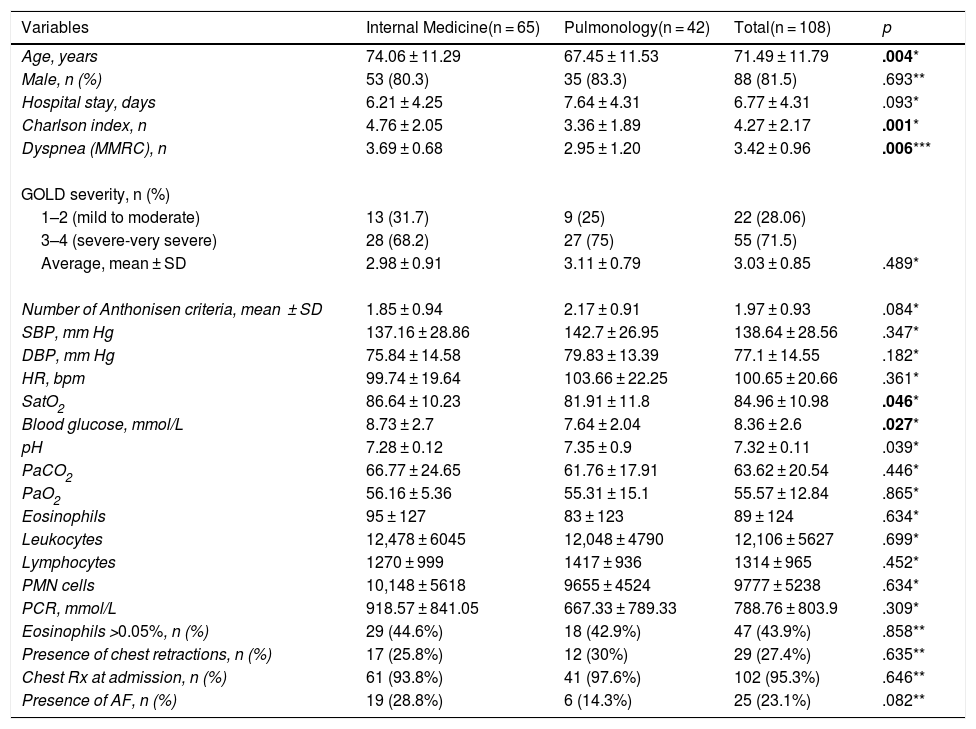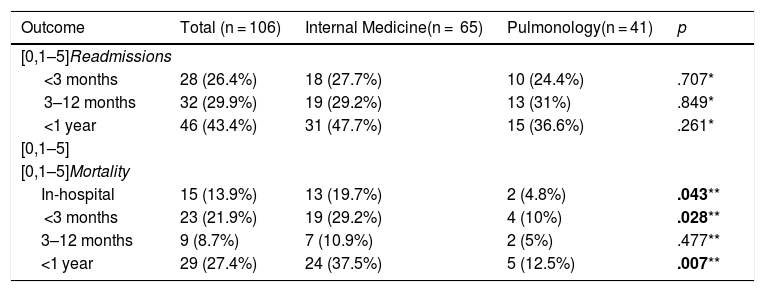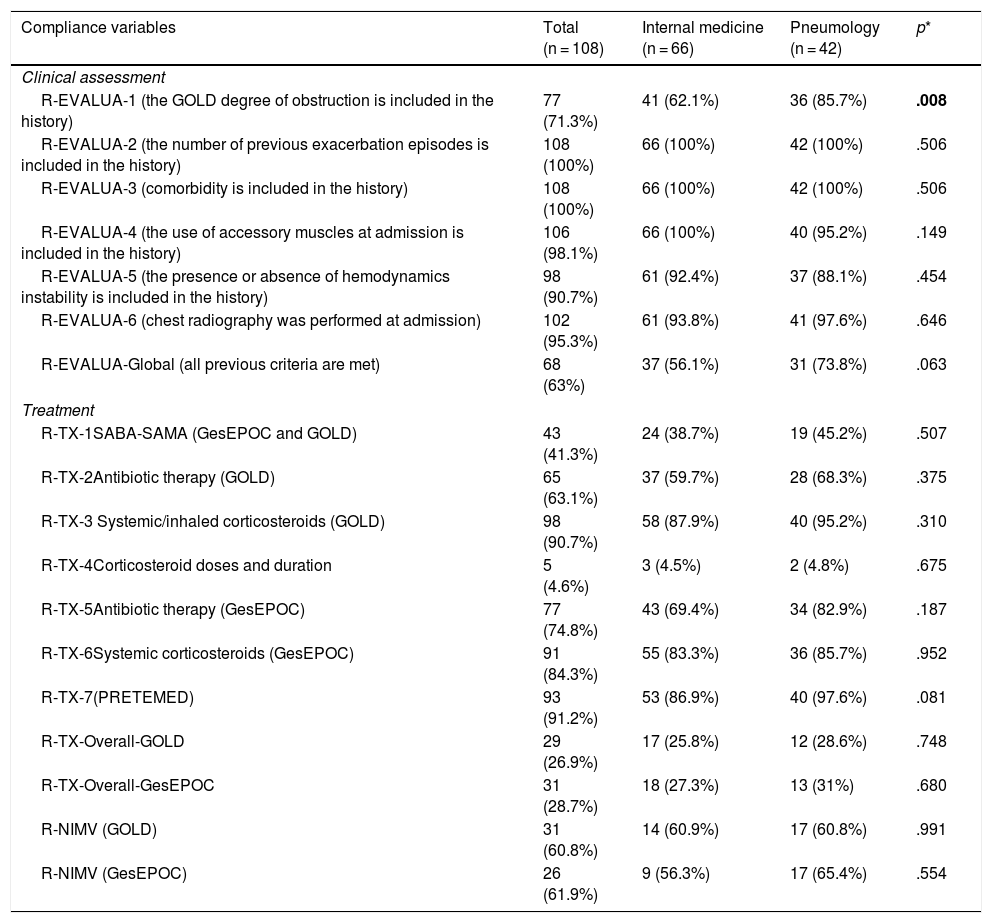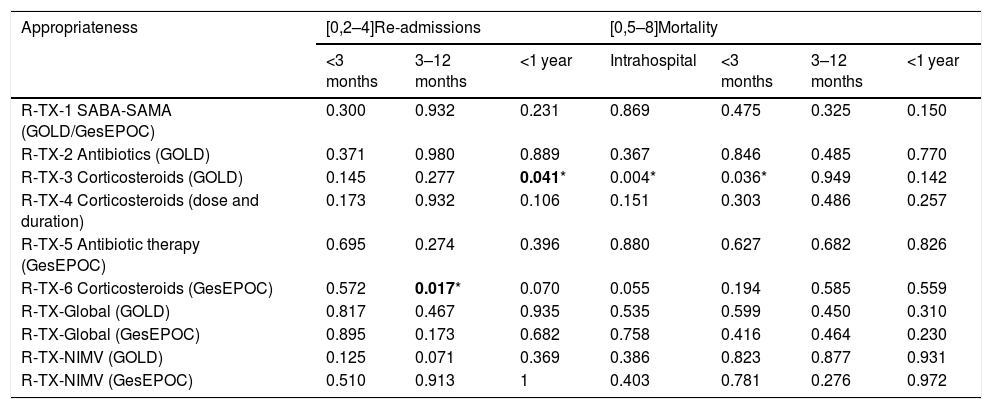To define the clinical characteristics of patients hospitalised in pneumology and internal medicine departments for chronic obstructive pulmonary disease (COPD) exacerbation, to assess the compliance with the recommendations of the clinical practice guidelines and to determine the impact on the patients’ prognosis.
MethodologyWe conducted a retrospective longitudinal study that randomly included patients hospitalised for COPD exacerbation in a tertiary hospital. We collected demographic and clinical variables (degree of dyspnoea and obstruction, previous exacerbations, comorbidities), readmission and mortality data and criteria for compliance with the Global Initiative for Chronic Obstructive Lung Disease (GOLD) guidelines and the Spanish COPD guidelines (GesEPOC). We performed a univariate, multivariate and survival analysis.
ResultsThe study included 108 patients, and the mean age was 71.48 ± 11.65 years. The readmission rate was 26.4% at 3 months and 43.4% at 1 year. The hospital mortality rate was 3.9%, the mortality rate at 3 months was 21.9%, and the mortality rate at 1 year was 27.4%. The patients hospitalised in the internal medicine department had higher mortality during hospitalisation (p = .043), at 3 months (p = .028) and at 1 year (p = .007) compared with the rates for the pneumology department. Overall compliance with the clinical guidelines was 63% for the clinical evaluation (less for the patients in internal medicine: 56.1% vs. 73.8%, p = .063). For the treatment, the compliance was 26.9% for GOLD and 28.7% for GesEPOC. Compliance with the GOLD guidelines in the use of corticosteroids was associated with a lower rate of long-term readmissions (p = .041) and hospital mortality (p = .007) and 3-month mortality (p = .05).
ConclusionsThe clinical profile of the patients is currently similar to that previously reported, but their clinical progression was poorer. Overall compliance with the clinical guidelines for drug treatment was low, and only appropriate use of systemic steroids was associated with a reduction in early mortality and in medium-term readmissions.
Definir las características clínicas de los pacientes hospitalizados en servicios de medicina interna (MI) y neumología por exacerbaciones de la EPOC, evaluar la adecuación a las recomendaciones de las guías de práctica clínica y conocer su impacto en el pronóstico de los pacientes.
MetodologíaEstudio longitudinal retrospectivo. Se incluyeron aleatoriamente pacientes ingresados por exacerbación de EPOC en un hospital de tercer nivel. Se registraron variables demográficas, clínicas (grado de disnea y de obstrucción, exacerbaciones previas, comorbilidades), criterios de adecuación a las guías clínicas GOLD y GesEPOC y datos de reingresos y mortalidad. Se realizó un análisis univariante, multivariante y de supervivencia.
ResultadosSe incluyeron 108 pacientes y la edad media fue de 71,48±11,65 años. Los reingresos a los 3 meses fueron un 26,4% y al año un 43,4%. La mortalidad intrahospitalaria fue del 3,9%, a los 3 meses del 21,9%, y al año del 27,4%. Los pacientes ingresados en MI tuvieron una mortalidad más elevada durante el ingreso (p = 0,043), a los tres meses (p = 0,028) y al año (p = 0,007) respecto a los de neumología. La adecuación global a las guías clínicas en la evaluación clínica fue del 63% (menor en los pacientes de MI: 56,1% vs. 73,8%, p = 0,063), y en el tratamiento del 26,9% para la GOLD, y del 28,7% para GesEPOC. La adecuación en el uso de corticoides según GOLD se asoció a menor tasa de reingresos al año (p = 0,041) y mortalidad intrahospitalaria (p = 0,007) y a los 3 meses (p = 0,05).
ConclusionesEl perfil clínico de los pacientes es actualmente similar al descrito previamente pero su evolución clínica fue peor. La adecuación global del tratamiento farmacológico a las guías clínicas es baja, y solo el uso adecuado de esteroides sistémicos se asocia a una reducción de la mortalidad precoz y de los reingresos a medio plazo.
Article
Diríjase desde aquí a la web de la >>>FESEMI<<< e inicie sesión mediante el formulario que se encuentra en la barra superior, pulsando sobre el candado.

Una vez autentificado, en la misma web de FESEMI, en el menú superior, elija la opción deseada.

>>>FESEMI<<<











